
The yen is the official currency of Japan. It is the third-most traded currency in the foreign exchange market, after the United States dollar and the euro. It is also widely used as a third reserve currency after the US dollar and the euro.

Hayato Ikeda was a Japanese bureaucrat and later politician who served as prime minister of Japan from 1960 to 1964. He is best known for his Income Doubling Plan, which promised to double Japan's GDP in ten years.

Kakuei Tanaka was a Japanese politician who served in the House of Representatives from 1947 to 1990, and was Prime Minister of Japan from 1972 to 1974.
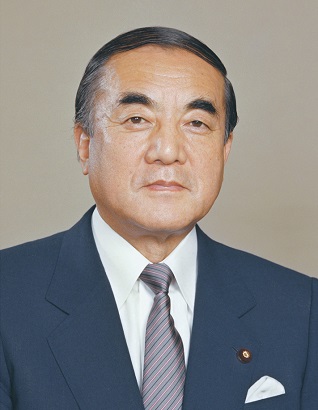
Yasuhiro Nakasone was a Japanese politician who served as Prime Minister of Japan and President of the Liberal Democratic Party from 1982 to 1987. He was a member of the House of Representatives for more than 50 years. His political term was best known for pushing through the privatization of state-owned companies and pursuing a hawkish and pro-U.S. foreign policy.

Noboru Takeshita was a Japanese politician who served as Prime Minister of Japan from 1987 to 1989 during the bubble economy.
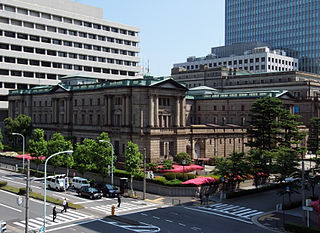
The Bank of Japan is the central bank of Japan. The bank is often called Nichigin (日銀) for short. It is headquartered in Nihonbashi, Chūō, Tokyo.

Postwar Japan is the period in Japanese history beginning with the surrender of Japan to the Allies of World War II on 2 September 1945, and lasting at least until the end of the Shōwa era in 1989.

The economic history of Japan is most studied for the spectacular social and economic growth in the 1800s after the Meiji Restoration. It became the first non-Western great power, and expanded steadily until its defeat in the Second World War. When Japan recovered from devastation, it became the world's second largest economy behind the United States until 2010, when it was overtaken by China, followed by Germany in 2023. Scholars have evaluated the nation's unique economic position during the Cold War, with exports going to both U.S.- and Soviet-aligned powers, and have taken keen interest in the situation of the post-Cold War period of the Japanese "lost decades".
Koenkai are an invaluable tool of Japanese Diet members, especially of the Liberal Democratic Party (LDP). These groups serve as pipelines through which funds and other support are conveyed to legislators and through which the legislators can distribute favors to constituents in return. To avoid the stringent legal restrictions on political activity outside of designated campaign times, koenkai sponsor year-round cultural, social, and "educational" activities. For example, Tanaka Kakuei used his "iron constituency", or invincible constituency, in rural Niigata Prefecture to build a formidable, nationwide political machine. But other politicians, like Ito Masayoshi, were so popular in their districts that they could refrain, to some extent, from money politics and promote a "clean" image. Koenkai remained particularly important in the over-represented rural areas, where paternalistic, old-style politics flourished and where the LDP had its strongest support.
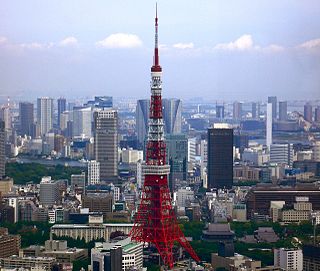
The Japanese asset price bubble was an economic bubble in Japan from 1986 to 1991 in which real estate and stock market prices were greatly inflated. In early 1992, this price bubble burst and Japan's economy stagnated. The bubble was characterized by rapid acceleration of asset prices and overheated economic activity, as well as an uncontrolled money supply and credit expansion. More specifically, over-confidence and speculation regarding asset and stock prices were closely associated with excessive monetary easing policy at the time. Through the creation of economic policies that cultivated the marketability of assets, eased the access to credit, and encouraged speculation, the Japanese government started a prolonged and exacerbated Japanese asset price bubble.
The main elements of Japan's financial system are much the same as those of other major industrialized nations: a commercial banking system, which accepts deposits, extends loans to businesses, and deals in foreign exchange; specialized government-owned financial institutions, which fund various sectors of the domestic economy; securities companies, which provide brokerage services, underwrite corporate and government securities, and deal in securities markets; capital markets, which offer the means to finance public and private debt and to sell residual corporate ownership; and money markets, which offer banks a source of liquidity and provide the Bank of Japan with a tool to implement monetary policy.
In the postwar decades, the standard of living in Japan has undergone a dramatic rise. Some observed changed has been a reduction of the gap between blue and white collar workers. What was once considered the "three sacred treasures", was possessed by 90% of households by 1964. By the 1970's, the living conditions of the working class were considered to be as high as those in the West. Japanese consumers have benefited from the nation's economic growth, while in turn they have stimulated the economy through demand for sophisticated products, loyalty to domestically produced goods, and saving and pooling investment funds. But personal disposable income has not risen as fast as the economy as a whole in many years—at 1 percentage point less than average GNP growth in the late 1980s.
In its economic relations, Japan is both a major trading nation and one of the largest international investors in the world. In many respects, international trade is the lifeblood of Japan's economy. Imports and exports totaling the equivalent of nearly US$1.309.2 Trillion in 2017, which meant that Japan was the world's fourth largest trading nation after China, the United States and Germany. Trade was once the primary form of Japan's international economic relationships, but in the 1980s its rapidly rising foreign investments added a new and increasingly important dimension, broadening the horizons of Japanese businesses and giving Japan new world prominence.

The trade policy of Japan related to Japan's approach to import and export with other countries.

The Japanese economic miracle refers to Japan's record period of economic growth between the post-World War II era and the end of the Cold War. During the economic boom, Japan rapidly became the world's second-largest economy. By the 1990s, Japan's population demographics had begun to stagnate, and the workforce was no longer expanding as quickly as it had in the previous decades despite per-worker productivity remaining high.

General elections were held in Japan on 18 July 1993 to elect the 511 members of the House of Representatives. The Liberal Democratic Party (LDP), which had been in power since 1955, lost their majority in the House. An eight-party coalition government was formed and headed by Morihiro Hosokawa, the leader of the Japan New Party (JNP). The election result was profoundly important to Japan's domestic and foreign affairs.
Takao Fujinami was a Japanese politician, former Chief Cabinet Secretary and House of Representatives member.

Japan has the highest proportion of elderly citizens of any country in the world. 2014 estimates showed that about 38% of the Japanese population was above the age of 60, and 25.9% was above the age of 65, a figure that increased to 29.1% by 2022. By 2050, an estimated one-third of the population in Japan is expected to be 65 and older.
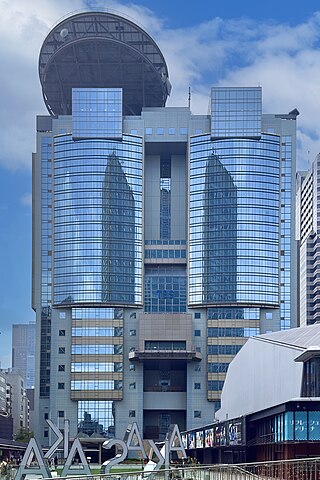
JORX-DTV, branded as TBS Television, is the Kantō region flagship station of the Japan News Network. It is owned-and-operated by Tokyo Broadcasting System Television, Inc., a subsidiary of TBS Holdings. TBS Television is one of the ''five private broadcasters based in Tokyo''.
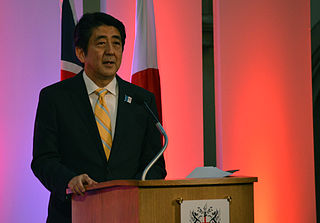
Abenomics refers to the economic policies implemented by the Government of Japan led by the Liberal Democratic Party (LDP) since the December 2012 general election. They are named after Shinzō Abe (1954–2022), who had been appointed as Prime Minister of Japan on his second term from 2012 to 2020. Abe was the longest-serving prime minister in Japanese history. After Abe resigned in September 2020, his successor, Yoshihide Suga, stated that his premiership would focus on continuing the policies and goals of the Abe administration, including the Abenomics suite of economic policies.





















